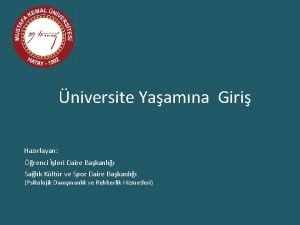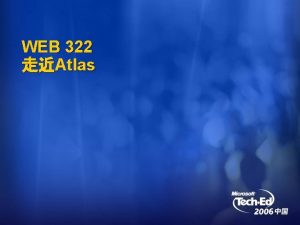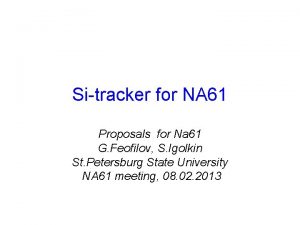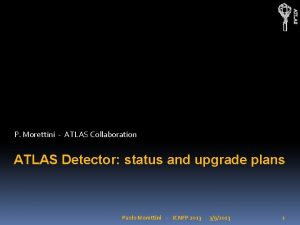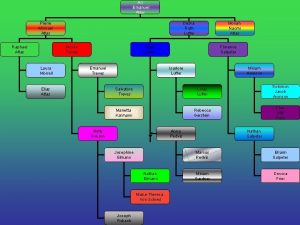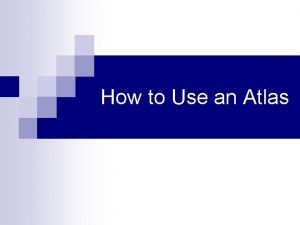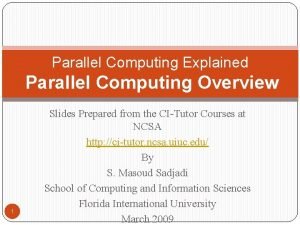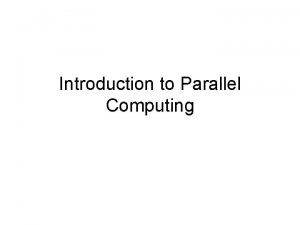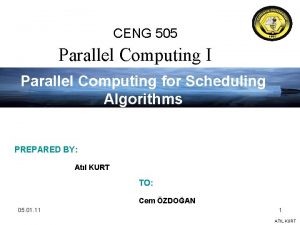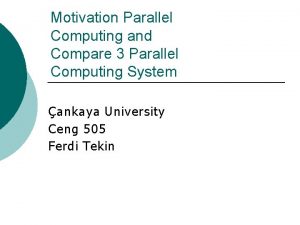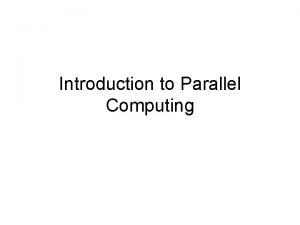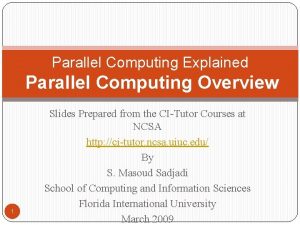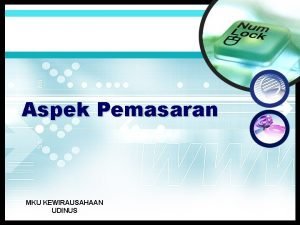1 MKU Computing for ATLAS SiTracker Parallel Computing
























- Slides: 24

1 MKU //- Computing for ATLAS Si-Tracker Parallel Computing Studies for the Alignment of the ATLAS Silicon Tracker Müge Karagöz Ünel (the University of Oxford) K. Bernardet, P. Brückman, A. Hicheur the Atlas Collaboration 12/16/2021 Computing in HEP, T. I. F. R. , Mumbai 13 -17 February, 2006 ● Motivation: Alignment of Si-tracker ● Tests with random matrices ● Case-studies using ATLAS MC data Temple in Tamil Nadu, www. sacredcities. com

2 MKU //- Computing for ATLAS Si-Tracker The Fact: Atlas Silicon System has ~ 35 k Do. F

3 MKU //- Computing for ATLAS Si-Tracker The Idea: Global 2 Method for Alignment The method consists of minimizing a giant 2 resulting from a simultaneous fit of all particle trajectories and alignment parameters. ● See Adlene Hicheur’s talk for more on Global 2 algorithm as well as ATLAS alignment issues. ●

4 The Problem: Limitations Global 2 formalism requires solving large number of linear equations and handling large sized-matrices in its full scope, due to the large number of Do. F in the Atlas tracker system. MKU //- Computing for ATLAS Si-Tracker ● Using 32 -bit single-CPU platforms is a limiting factor in performance (ATLASMarseille): ● ● Size: * A matrix of N=35 k needs 9. 8 GB disk space and at least the same amount of virtual space for computations. * A 32 -bit program can only address 4 GB of virtual memory. * By default, Atlas software infrastructure allows only 2 GB of memory per job. ● Precision: Conventional 32 -bit libraries are not fully adequate for full size solution computational accuracy (35 k-Do. F). The matrices of alignment problems can have large condition numbers which may compete with the machine precision. ● Execution time: Single-CPU machines can take a good number of hours to solve large-size problems, even if they can!

5 //- Computing for ATLAS Si-Tracker The Solution: //-processing with 64 -bit Architecture Solution: 64 -bit architecture with parallel processing and distributed-memory libraries for matrix algebra! ● Size: ● ● e. g. , distributed on 16 processors, required memory for 35 k-size matrix is only 0. 6 GB/CPU. Allowance of up to 16 GB virtual memory. Precision: Hope to increase the numerical precision, making use of the enlarged data type sizes and extended-precision libraries. ● Execution times: Parallel processing allows faster execution times distributing the CPU load. MKU ●

6 The Platform: Beowulf cluster at RAL (SCARF) SCARF is a 64 -bit AMD Opteron cluster at Rutherford Lab, shared by various groups within the CCLRC users. MKU //- Computing for ATLAS Si-Tracker ● Its hardware matches (and exceeds) the suggested requirements for Atlas alignment algorithms. ● Asgard (ETH Zurich) Suggested SCARF (RAL) 32 -bit 64 bit dual, 240 Large N dual, 128 CPU PIII 500/600 MHz AMD Opteron 2 GHz AMD Opteron 248 2. 2. GHz RAM 1 G 4 G 4 G (122 nodes), 8 G (16 nodes) Persistent - 40 GB IDE 2 x 120 GB IDE Network - 1 x Gigabit 2 x Gigabit Architecture # nodes

7 MKU //- Computing for ATLAS Si-Tracker The Platform: Available Software ● SCARF executes x 86 code natively. ● It runs Red Hat Enterprise (ES) Linux 3. 0. ● Equipped with PGI and GNU compilers for C, C++ and Fortran, ● LSF (v 6. 1) for queuing system and MPI (v 1. 2. 6. . 14 a) for message-passing, AMD Core Math Library (ACML) (v 2. 5. 0) with Sca. LAPACK (v 1. 7) and BLACS (v 1. 1). ● ● We used AMD Sca. LAPACK libraries for 64 -bit compilation.

8 The Choices: Available Infrastructure Available compiler options on SCARF: GNU (GCC 3. 2. 3 -53) vs PGI (5. 2). ● Pros&cons: ● GNU is publicly available, PGI is not. ● GNU long double size is 16 B on 64 -bit architecture. PGI does not support quad. precision (l. d. size is 8 B). ● We test time and precision performance, by calculating A=B*3 -1, B=1. 3. ● Time performances are slightly better for optimized (O 3) GNU. 3 orders of magnitude improvement in precision from double to l. d. with GNU. MKU //- Computing for ATLAS Si-Tracker ● (Note: AMD Opteron holds 80 -bit f. p. registers & l. d. f. p. is a 80 -bit extended type. ) ● We chose to continue to use GNU compiler.

9 The Choices: Possible Software and Libraries A variety of matrix algebra and solver software exists. Some examples: ● Sca. LAPACK and PLAPACK (based on LAPACK) ● NAG parallel libraries (contains also Sca. LAPACK) ● Pros & cons for Sca. LAPACK: ● AMD-Sca. LAPACK is optimized for high performance on AMD Opteron. ● Previous tests showed that Sca. LAPACK eigenvalue solver (upcoming slides) performs faster than that of PLAPACK’s (HPCx group). ● Sca. LAPACK (non-optimized) is a public domain software and can be downloaded from the web. NAG libraries require licence. However, this means they come with guaranteed tech. support! ● No general quad. precision library exists for NAG or SCALAPCK… Sca. LAPACK has been working on implementation for a new release. NAG already has in place iterative refinement procedures – not real extended precision, however, slows down the solution. Preconditioning the system should help in any case. ● We used Sca. LAPACK on SCARF for our initial proof-of-principle studies. MKU //- Computing for ATLAS Si-Tracker ●

10 Performance using Randomly-Generated Matrices ● We tested direct matrix inversion, with pdgesvx of Sca. LAPACK, an expert driver //- Computing for ATLAS Si-Tracker routine to solve linear equations. AMD Sca. LAPACK for distributed-memory computing for matrix operations; MPI for intra-processor communication, were used. ● The test matrices are symmetric, generated randomly, kept in binary format, double precision. Sizes scale as ~ N*N*8 B. ● Processing time and accuracy as a function of Size(A) and N(CPU) were measured. ● A scan of Size(A) and N(CPU) for various block sizes of the matrix distribution was also obtained. ● Size(A) 16384 N(CPU) 16 (4 x 4) Size(Block) MKU Reciprocal Cond(A) 64 x 64 0. 000024834271 Machine 0. 0000000011102 ||A*A-1 -I|| 0. 000047526382 Wall. Time (for routine) 49005. 65 s

11 Performance in Processing Time: MKU //- Computing for ATLAS Si-Tracker ● We measured the wall and CPU times for the Sca. LAPACK routine. We observed minor dependence of performance on the processor grid block size. However, we found that 32 CPUs with 64 MB is optimum for the range we’d like to cover. ● ● For an 8000 matrix, Wall. Time shows ~ N(CPU)-0. 2 dependence. 64 -bit AMD showed and improvement of a factor of 2. 5 in Wall. Time when compared with a 32 -bit AMD @ 2. 4 GHz using the same parameters. ● ● We 2 D-scanned the time performance in NCPU and S(grid). ● Large CPU cases not easy to test: queue-waiting long – it’s a shared machine! ● The results for the scan is linked here 4 x 4 grid

12 Earlier Results with a 32 -bit //-cluster: Random matrix Inversion results using system specified earlier (Asgard) ● As a function of size of random matrices: N 3 dependence of CPU time. ● Accuracy loss at around sizes of N=14 k. ● No scan of parameters as a function of grid block size was performed. ● Quadrupole precision was tested on MAPLE for N=200 (processing times enormously long) and results used to extrapolate to large sample sizes. MKU //- Computing for ATLAS Si-Tracker ●

13 Performance in Precision The number of accurate decimal digits is related to the exponent of condition number of matrix: cond(A). //- Computing for ATLAS Si-Tracker ● Number of digits preserved in the final solution can be calculated as acc= log[(AAT -I) x cond(A)]. ● The precision loss in the final result is improved over earlier results (~N=16 k), however not substantially, as we are not able to use quadrupole precision. ● Note: Sca. LAPACK has plans on extended precision (iterative refinement using XBLAS), but not in place yet. . . ● MKU ~16 k

14 Atlas MC Data – The Setup and the Sample A single sample was simulated and reconstructed in ATLAS inner detector. 825 k events exist in the sample: ~1/2 being +. ● Generation, simulation and reconstruction were performed using a very recent release of the ATLAS software framework (ATHENA, v 11. 0. 3). ● Production was carried out on the Oxford Particle Physics Linux cluster, running SLC 3, using PBS. One full chain per event took ~5 -10 s, integrated processing time of ~1000 hrs. ● Track transverse momenta distribution is flat: 20 < p. T< 100 Ge. V. ● -range is chosen with a flat distribution: [-2, 2], is full and uniform. ● Full setup consist of barrel Pix+SCT region, which corresponds to 3568 modules, and 21408 Do. F. MKU //- Computing for ATLAS Si-Tracker ● for 5000 events Note: As track statistics are not abundant, we will discuss solution performances rather than try to demonstrate the ultimate achievable precision in the solution properties.

15 The Software Setup for Solution After track processing, the global 2 algorithm generates a binary matrix to be solved for the eigenvalues and eigenvectors of the problem. ● For this study, we used a standalone version of the algorithm, ported it also to SCARF, and solved the matrix on the cluster. ● The solution was then used to extract the alignment corrections. ● We compared two platforms for the solver: SCARF vs Intel Pentium machines with 2 GB RAM, 2 GB swap, and 2. 8/2 GHz CPU. //- Computing for ATLAS Si-Tracker ● //-cluster AMD Opteron (64 -bit) Library LAPACK Sca. LAPACK Routine dspev pdsyevd Compiler g++ (GCC 3. 2. 3 -49) gcc (GCC 3. 2. 3 -53) Linux version 2. 4. 21 -32. 0. 1. ELsmp 2. 4. 21 -37. ELsmp pdsyevd: a simple Divide-and-Conquer routine (i. e. , recursive reduction of an instance of the problem into one or more smaller instances. ) ● MKU Intel Pentium. IV (32 -bit)

16 MKU //- Computing for ATLAS Si-Tracker Solving Various Size Problems for Barrel Tracker: cone SCT PIX+SCT #modules 1030 2112 3568 #Do. F 6180 12672 21408 #tracks ~250 k ~550 k ~800 k h=2 SCT PIX

17 Start with the “cone” Size Problem (6 k-Do. F) Cone Configuration: Align the limited geometry by using muon tracks in restricted (~1030 PIX+SCT modules). ● This configuration is the only one studied extensively earlier: small problem size. ● Agreement between Single-CPU and //-CPU is very good. MKU //- Computing for ATLAS Si-Tracker ●

18 Solve Barrel SCT Problem (12 k-Do. F): 1 SCT module remains unpopulated: 6 real spurious modes in matrix as well as some others due to limited statistics. ● This size of a problem can be “solvable” in both single and parallel platforms. ● A factor of ~50 is gained in time performance. MKU //- Computing for ATLAS Si-Tracker ●

19 Solve Full Barrel Problem (21 k Do. F): Extended the problem to solve full barrel size. ● A number of pixel modules unpopulated (37), due to coverage limitation in current sample. ● Problem only can be solved on SCARF cluster, unless matrix is written in triangular format (libraries linked with ATLAS software imposes file size limitations of 2 GB on the P 4 machines) ● Size dependence ~N 2. 3 and N(CPU) dependence ~ N-0. 5 (using results from MKU //- Computing for ATLAS Si-Tracker ● our earlier samples with an obsolete Athena release).

20 Comparison of Platforms for Global 2 Solution: Parallel-computing allowed for large problem solutions in a very efficient way. ● The time performance looks very advantageous! ● Number of modules in parantheses show the modules not taken into account for alignment. //- Computing for ATLAS Si-Tracker ● Nmodule Processing time* Nx. N(triang) SCARF NCPU=16 / 4 (2. 2 GHz, MB=256 MB) Intel Pentium. IV SCARF single-CPU 1030 (0) 6180 0. 3 (0. 15) 1 m 53 s / 3 m 35 m (2. 8 GHz) 39 m 2112 (1) 12672 1. 2 (0. 6) 10 m 30 s / 26 m 58 s 7 h 34 m (2 GHz) 5 h 28 m 3568 (37) 21408 3. 4 (1. 7) 43 m 43 s/ 121 m 51 s --- >20 hrs * Measurements include the binary file I/O. Also attempted invert these singular matrices. Matrices either found completely singular (as expected) (RCOND=0. 0) or RCOND< (Do. F=6180), and no solution is provided. ● MKU NDo. F File size(GB)

21 Summary & Conclusions: We performed tests on using distributed-memory parallel-computing for ATLAS alignment. ● For large scale problems, parallel-computing is very adventageous. ● The performances we obtained are improvements over earlier test results on other platforms. ● Now that we can run on large system sizes and able to obtain final alignment constants, the algorithm and numerical issues will be debugged and understood better. ● ATLAS has plans to port the offline software to 64 -bit mid-summer in conjunction with gcc 3. 4. 4 migration. When this happens, a better infrastructure will be in place for global 2 alignment processing. ● We are exploring all possibilities other than we used here (libraries, etc. . ): this is still work in progress… //- Computing for ATLAS Si-Tracker ● MKU Acknowledgments: We are grateful to the CCLRC group for their permission to use their Beowulf cluster. ● We are grateful to the Ox. PP Sys. Ops and Laura Gilbert who is responsible for ATLAS software installations on the Ox. PP cluster. ●

MKU //- Computing for ATLAS Si-Tracker Backup Slides SCT modules “Weak” modes 22

23 The Building Blocks: Barrel Modules MKU ~140 mm Si Sensors Hybrid with ASICs ~70 mm //- Computing for ATLAS Si-Tracker ASICs TPG+Be. O Baseboard Si Sensor ● PIXel detectors provide real 2 -D readout. ● Pixels are of size 50 400 m resulting in 14 115 m resolution. ● SCT modules are double-sided strip detectors with 1 -D readout per side. ● Sensitive strips have pitch of 80 m giving 23 m resolution. ● Stereo-angle of 40 mrad gives 580 m resolution in the other direction. ● Entire tracker is equipped with binary readout.

24 MKU //- Computing for ATLAS Si-Tracker Examples of ‘Weak Modes’: “clocking” R (VTX constraint) radial distortions (various) “telescope” z~R We need extra handles in order to tackle these. The natural candidates are: • Requirement of a common vertex for a group of tracks (VTX constraint), • Constraints on track parameters or vertex position, • External constraints on alignment parameters. dependent sagitta X a b. R c. R 2 dependent sagitta “Global twist” Rcot( )
 Mkü harf notu sistemi
Mkü harf notu sistemi Klassificeringsstruktur för kommunala verksamheter
Klassificeringsstruktur för kommunala verksamheter Returpilarna
Returpilarna Läkarutlåtande för livränta
Läkarutlåtande för livränta Påbyggnader för flakfordon
Påbyggnader för flakfordon Tack för att ni lyssnade
Tack för att ni lyssnade Tobinskatten för och nackdelar
Tobinskatten för och nackdelar Egg för emanuel
Egg för emanuel Atmosfr
Atmosfr Vilotidsbok
Vilotidsbok Rutin för avvikelsehantering
Rutin för avvikelsehantering Mitos steg
Mitos steg Lågenergihus nyproduktion
Lågenergihus nyproduktion Rbk mätning
Rbk mätning Kontinuitetshantering i praktiken
Kontinuitetshantering i praktiken Myndigheten för delaktighet
Myndigheten för delaktighet Presentera för publik crossboss
Presentera för publik crossboss Var 1721 för stormaktssverige
Var 1721 för stormaktssverige Tack för att ni har lyssnat
Tack för att ni har lyssnat Stig kerman
Stig kerman Hur ser ett referat ut
Hur ser ett referat ut Kraftledning karttecken
Kraftledning karttecken Luftstrupen för medicinare
Luftstrupen för medicinare Shingelfrisyren
Shingelfrisyren Lufttryck formel
Lufttryck formel
